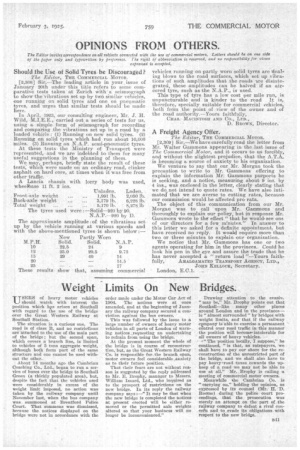Weight Limits On New Bridges.
Page 25

If you've noticed an error in this article please click here to report it so we can fix it.
T T SERB of heavy motor vehicles
should watch with interest the position which lips arisen at Southall with regard to the use of the bridge over the Great Western Railway at Southall Station.
The situation is a curious one. The road is of class B. and no restrictions ar-ttached to the use of the main part of the bridge ; but the second span, which covers a branch line, is limited to vehicles of 5 tons aggregate weight, although both form part of the same structure and one cannot be used without the other.
About 14 months ago the Cambrian Coaching Co., Ltd., began to run a service of buses over the bridge to Southall Green (a thickly populated area), but, despite the fact that the vehicles used were considerably in excess of the weight limit imposed, no action was taken by the railway company until November last, when the bus company was summoned at Brantford Police Court. That summons was dismissed, because the notices displayed on the bridge were not in accordance with the
order made under the Motor Car Act of 1904. The notices were at once amended, and at the beginning of January the railway company secured a conviction against the bus owners. '
This was followed by the issue to a large number of owners of heavy motor vehicles in all parts of London of warning notices requesting an undertaking to refrain from using the bridge: At the present moment the whole of the bridge is in course of reconstruction, but, as the Great Western Railway Co. is responsible for.the branch span, motor owners feel considerable :anxiety as to their futnre position.
That their fears are not without reason is suggested by the reply addressed to Mr. a Brophy, manager to Messrs. William Iszard, Ltd., who inquired as to the prospect of restrictions on the new bridge. In its reply the railway company says :—" It may be that when the new bridge is completed the notices at present erected will be either removed or the permitted axle weights altered so that your business will no longer be inconvenienced."
Drawing attention to the evasiv, "way be," Mr. Brophy points out that Southall—like many other places around London and in the provinces— is "almost surrounded" by bridges with weight limits, and that if the railway company is able to exercise a permanent antrol over road traffic in this manner the position will become. intolerable for all owners of heavy vehicles.
J" The position locally, I suppose," he continued, "is that, as ratepayers, we shall have to pay our share for the reconstruction of the unrestricted part of the bridge, and we shall also have to pay heavy,road taxes towards the upkeep of a road we may not be able to use at all." Mr. Brophy is calling a meeting of commercial motor owners.
Meanwhile the Cambrian Co. is "carrying on," holding the opinion, as expressed by its counsel (Mr. H. D. Roane) during the police court proceedings, that the Prosecution was merely an attempt on the. part of the railway company to defeat a rival conce1n. and to evade its obligations with respect to the new bridge.




























